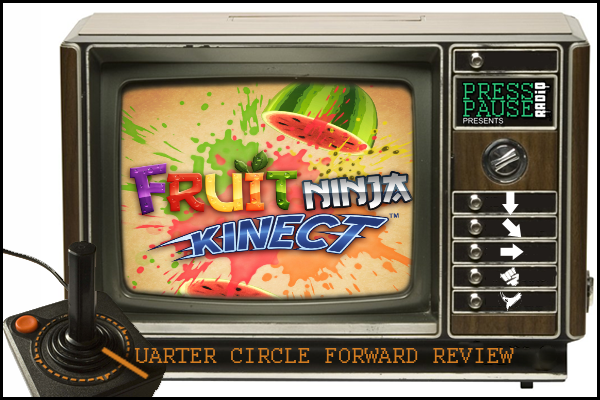
Are you finding yourself utterly disgusted from the sight of an apple? Have all those years of slipping on banana peels left you emotionally crippled? For all of you passionate carnivores out there, Half-brick has the game for you!
Fruit Ninja, the twenty million selling hit, has now landed on the Xbox 360. It also utilizes the Kinect, which has seen little or no support since its release last November. Half-Brick intends to change that trend, but the twenty million dollar question falls on whether or not Fruit Ninja Kinect is worth the investment.
Half-brick had their work cut out for them as they labored to recreate the experience of Fruit Ninja for the Xbox 360, while justifying its price of admission. Kinect, however, plays a key-role in bridging the gap that allows these ideas to come into fruition (pun intended). The core mechanic behind Fruit Ninja is your skill of reflex and reaction, as you use your fingers to slice fruit that flies from the bottom of the screen. Avoiding obstacles in the process, fruit will jet upward through various patterns and amounts while you attempt to slice every single one. The game will end if you either miss too many pieces of fruit in a hot-potato fashion, or if you fall prey to one of the aforementioned obstacles while adapting to varying conditions dependant on the selected mode of play. Beyond just slicing fruit, you’re rewarded extra points if you score a critical slash, or cut through three or more pieces of fruit within one swipe. You're also given special power-up fruits, which give you added bonuses or affect the play conditions in your favor.
With the basics explained, I’d like to start with the most skeptical component of the game involving a new approach to controls. Fruit Ninja Kinect executes this surprisingly well, while being able to emulate the feel of its smart-phone counterpart, and remaining intuitive to its new format. It accomplishes this by placing your own silhouette against the backdrop during gameplay; by doing this, your shadow is the key-element of how you navigate your limbs. Posing as an alternative to fingers, your appendages are what allow you to cut through the rushing fruit. This play mechanic incredibly transitions the experience but retains the familiar appeal. Slicing through fruit and avoiding obstacle feels more and more natural, right down to instinctually controlling the inertia behind your swipes in an effort to be successful in the stage. Where the controls fail, however, is ironically in the interface. In order to refashion the familiarity of the interface from its smart-phone predecessor, this menu design was simply not meant to compliment the same harmonious feel with the Kinect. Options are represented by stationary fruit, which provide different choices to navigate in and out of the game, and are confirmed by -- you guessed it -- slicing through them. The placement of fruit is scattered about the screen, and while this works for a smaller smart-phone screen, the same can’t be said for larger televisions. In order to select options, you're usually required to physically move; this just feels unnecessarily awkward and annoying at times.

The modes are exactly what's offered in the original, with the addition of a challenge selection that operates in a completely random mission format, and combines objectives of all the existing modes but multiplayer. Classic mode is a test of endurance where you try to slice as much fruit as possible, while avoiding bombs that end the round immediately; missing three pieces of fruit will also earn the same outcome. Zen mode is a free-for-all, which gives you 90 seconds to slice however much you can without having to avoid any obstacles or adhere to any conditions. Arcade mode involves getting the highest score you can, while avoiding bombs that can subtract ten points from your score, and using randomized power-up fruit to your advantage. Multiplayer feels the freshest in this iteration, as you have a local multiplayer option allowing either for co-op play on arcade mode, or a versus mode that involves slicing your own specific colored fruit on your end, while avoiding your opponents fruit to prevent loss of points. In addition to this score attack influenced mode, there are occasional pieces of fruit that fling by and give you extra points, but sadly no power-up fruit that gives you advantages over your opponent. Even in Multiplayer, Fruit Ninja Kinect still had this intuitive finesse in the operation of control. The same unlockable content can be found on this version along with an additional blades and backdrops, including one where you can see a direct reflection of yourself instead of a silhouette, and with awards for your Xbox avatar.

Overall, Fruit Ninja Kinect boasts very little additional content in comparison to its app counterpart; they’re nearly identical, sans the multiplayer and challenges. So what justifies the price of entry in its console cousin, when you can get a similar experience nine dollars cheaper? Easy answer: it’s a completely different experience. Where Fruit Ninja on-the-go provides the perfect portable time killer with your smartphone, the accessibility easily makes it one of the best third party games to get for the Kinect, and completely separates it from the mobile version. The accessible approach to the addictive gameplay is all kept with the advent of being able to switch in and out between friends, or enjoyed together through dedicated multiplayer gaming. In doing so, I can fully recommend purchasing Fruit Ninja Kinect and let’s be honest -- there aren't exactly a shit-ton of choices for games that support Kinect to root through. Fruit Ninja Kinect, however, offers plenty of incentive to play beyond the sole factor of participating in the elimination game of what to try from Kinect’s library, and encourages hope for the peripheral's existence.